July 2019
Athlete’s Foot
Athlete’s foot, or tinea pedis, is a skin disease caused by a fungal infection. The infection typically occurs between the toes, and the feet are most subject to this disease because shoes best create the warm, dark, and moist environment in which fungus thrives. Other areas that create a similar environment, such as swimming pools, public showers, and locker rooms; can also promote fungi growth.
Symptoms of athlete’s foot include dry skin, itching, scaling, inflammation, and blistering. Sometimes, blisters can evolve into the cracks or breaks in the skin. The exposed tissue can then create pain, swelling, and discharge. The spread of infection can cause itching and burning as well.
While athlete’s foot commonly occurs between the toes, it may also spread to the toenails or soles of the feet. Other parts of the body, such as the groin or underarms, can also become infected if they are touched after the original area of infection is scratched. Aside from physical contact, athlete’s foot can also spread through the contamination of footwear, clothing or bedsheets.
Proper foot hygiene is essential in preventing athlete’s foot. You can prevent the fungus from spreading by frequently washing your feet using soap and water, thoroughly drying the feet between the toes, changing shoes and socks every day to reduce moisture, and ensuring that bathroom and shower floors are disinfected. Other tips include using shower shoes, avoiding walking barefoot in public environments, wearing light and airy shoes, and wearing socks that keep the feet dry.
While treatment for athlete’s foot can involve topical or oral antifungal drugs, mild cases of the infection can be treated by dusting foot powder in shoes and socks. Any treatment used can be supplemented by frequently bathing the feet and drying the toes. If proper foot hygiene and self-care do not ease your case of athlete’s foot, contact your podiatrist. He will determine if the underlying cause of your condition is truly a fungus. If that is the case, a comprehensive treatment plan may be suggested with the inclusion of prescription antifungal medications.
Athlete’s Foot and Fungus
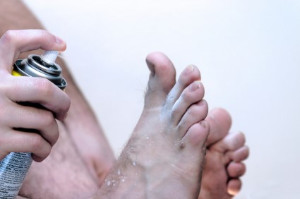 A skin disease that occurs on the feet and between the toes may be classified as athlete’s foot. This is caused by a contagious fungal infection. The fungus that causes this uncomfortable condition typically thrives in warm and moist environments. These often include gyms, public shower and locker room floors, in addition to pools and surrounding areas. The symptoms that are most often associated with this condition are burning sensations, and itchiness on the soles of the feet. If this is left untreated, blisters can develop, which can make it difficult to wear shoes. Relief may be found when shoes and socks that are made of breathable materials are worn, in addition to using an antifungal spray. If you feel you have contracted athlete’s foot, it is advised that you schedule an appointment with a podiatrist who can properly diagnose and treat this condition.
A skin disease that occurs on the feet and between the toes may be classified as athlete’s foot. This is caused by a contagious fungal infection. The fungus that causes this uncomfortable condition typically thrives in warm and moist environments. These often include gyms, public shower and locker room floors, in addition to pools and surrounding areas. The symptoms that are most often associated with this condition are burning sensations, and itchiness on the soles of the feet. If this is left untreated, blisters can develop, which can make it difficult to wear shoes. Relief may be found when shoes and socks that are made of breathable materials are worn, in addition to using an antifungal spray. If you feel you have contracted athlete’s foot, it is advised that you schedule an appointment with a podiatrist who can properly diagnose and treat this condition.
Athlete’s foot is an inconvenient condition that can be easily reduced with the proper treatment. If you have any concerns about your feet and ankles, contact Dr. Scott Shrem from Garden State Foot & Ankle Center. Our doctor will treat your foot and ankle needs.
Athlete’s Foot: The Sole Story
Athlete's foot, also known as tinea pedis, can be an extremely contagious foot infection. It is commonly contracted in public changing areas and bathrooms, dormitory style living quarters, around locker rooms and public swimming pools, or anywhere your feet often come into contact with other people.
Solutions to Combat Athlete’s Foot
- Hydrate your feet by using lotion
- Exfoliate
- Buff off nails
- Use of anti-fungal products
- Examine your feet and visit your doctor if any suspicious blisters or cuts develop
Athlete’s foot can cause many irritating symptoms such as dry and flaking skin, itching, and redness. Some more severe symptoms can include bleeding and cracked skin, intense itching and burning, and even pain when walking. In the worst cases, Athlete’s foot can cause blistering as well. Speak to your podiatrist for a better understanding of the different causes of Athlete’s foot, as well as help in determining which treatment options are best for you.
If you have any questions please feel free to contact our office located in Hazlet, NJ . We offer the newest diagnostic and treatment technologies for all your foot and ankle needs.
Treating Toenail Fungus
Fungal infection of the toenail, or onychomycosis, typically appears as a gradual change in a toenail’s texture and color that involves brittleness and darkening. The fungal infection itself occurs beneath the surface of the nail. Aside from discoloration, other symptoms include the collection of debris beneath the nail plate, white marks on the nail plate, and a foul odor emanating from the nail. If ignored, the infection can spread into other nails and the skin; in severe cases, it can hinder one’s ability to work or walk.
The toenails are particularly vulnerable to contracting infection in moist environments where people are likely to be walking barefoot, such as around swimming pools, public showers, and locker rooms. Fungal infection may also be more likely to occur in nail beds that have been injured, and sufferers of chronic diseases such as diabetes, circulatory problems, or immunodeficiency conditions are particularly prone to developing fungal nails.
Fungal nails can be primarily prevented by practicing proper hygiene and regularly examining the feet and toes. Carefully washing the feet with soap and water and thoroughly drying the feet afterwards are essential. Other tips include wearing shower shoes in public areas, changing shoes and socks daily, keeping toenails clipped at a short length, wearing breathable shoes that fit properly, wearing moisture-wicking socks, and disinfecting home pedicure tools and instruments used to cut nails.
Fungal nail treatment may vary between patients and the severity of the condition. Your podiatrist may suggest a daily routine of cleansing that spans over a period of time to ease mild infections. Over-the-counter or prescription antifungal agents may also be prescribed, including topical and/or oral medications. Debridement, or the removal of diseased nail matter and debris, may also be performed. In more severe cases, surgical treatment may be needed. In some instances, the temporary removal of the fungal nail allows for the direct application of a topical antifungal to the nail bed. In other cases, a chronically painful fungal nail that has not responded to other treatments may be permanently removed; this allows the infection to be cured and avoids the growth of a deformed nail.
How Does Toenail Fungus Enter The Body?
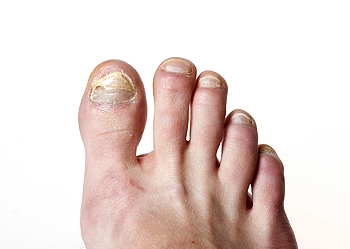 A toenail fungus is considered to be an infection of the nails. Common symptoms that are often associated with this condition can include noticeable discoloration of the toenails, and they may appear thick. Additionally, many patients see their nails beginning to crack, and this can cause an unsightly appearance. This type of fungus is known to be contagious, and typically lives and thrives in warm and moist environments. These often include public swimming pools and surrounding areas, shower room floors, and locker rooms. The fungus can enter through tiny cracks in the skin, and the toenails can gradually become affected. Patients who are diabetic or have a weakened immune system may be more likely to contract this type of fungus. There are methods that can be implemented which may help to prevent the fungus from entering the body. These include wearing appropriate shoes while in public areas, and avoiding sharing shoes, socks, or nail trimmers. If you have toenail fungus, please consult with a podiatrist who can offer proper treatment options.
A toenail fungus is considered to be an infection of the nails. Common symptoms that are often associated with this condition can include noticeable discoloration of the toenails, and they may appear thick. Additionally, many patients see their nails beginning to crack, and this can cause an unsightly appearance. This type of fungus is known to be contagious, and typically lives and thrives in warm and moist environments. These often include public swimming pools and surrounding areas, shower room floors, and locker rooms. The fungus can enter through tiny cracks in the skin, and the toenails can gradually become affected. Patients who are diabetic or have a weakened immune system may be more likely to contract this type of fungus. There are methods that can be implemented which may help to prevent the fungus from entering the body. These include wearing appropriate shoes while in public areas, and avoiding sharing shoes, socks, or nail trimmers. If you have toenail fungus, please consult with a podiatrist who can offer proper treatment options.
If left untreated, toenail fungus may spread to other toenails, skin, or even fingernails. If you suspect you have toenail fungus it is important to seek treatment right away. For more information about treatment, contact Dr. Scott Shrem of Garden State Foot & Ankle Center. Our doctor can provide the care you need to keep you pain-free and on your feet.
Symptoms
- Warped or oddly shaped nails
- Yellowish nails
- Loose/separated nail
- Buildup of bits and pieces of nail fragments under the nail
- Brittle, broken, thickened nail
Treatment
If self-care strategies and over-the-counter medications does not help your fungus, your podiatrist may give you a prescription drug instead. Even if you find relief from your toenail fungus symptoms, you may experience a repeat infection in the future.
Prevention
In order to prevent getting toenail fungus in the future, you should always make sure to wash your feet with soap and water. After washing, it is important to dry your feet thoroughly especially in between the toes. When trimming your toenails, be sure to trim straight across instead of in a rounded shape. It is crucial not to cover up discolored nails with nail polish because that will prevent your nail from being able to “breathe”.
In some cases, surgical procedure may be needed to remove the toenail fungus. Consult with your podiatrist about the best treatment options for your case of toenail fungus.
If you have any questions, please feel free to contact our office located in Hazlet, NJ . We offer the newest diagnostic and treatment technologies for all your foot care needs.
Taking Care of Elderly Feet
Many foot diseases and conditions become more serious and common among the elderly. Some of these conditions include diabetic ulcers, ingrown toenails, fungus, arthritis, corns, and calluses. Unfortunately, it may be harder for older adults to take care of their own feet, but there are some precautions they can take in order to avoid any serious conditions.
Dry, cracked heels tend to be a common problem for older people. In order to avoid this, you should always keep your feet clean and well moisturized. Special feet moisturizers should be used as average lotions might not provide enough moisture for dry and cracked heels. Daily foot inspections are crucial for the elderly to detect any irregularities in their earliest stages. During the aging process, blood circulation tends to slow down causing older people to not feel their feet as well as they used to. This often results in foot problems going unnoticed.
Fungal and bacterial conditions thrive on elderly feet because older adults are less likely to keep their feet clean and dry; this makes it easier for bacteria to take hold in their dry, cracked skin. Elderly people should be sure to thoroughly dry their feet, especially in between the toes, after bathing. This will help them avoid developing any fungal infections. Additionally, clean cotton socks should be worn after the feet are dried.
Cutting toenails straight across will help prevent ingrown toenails. When toenails are cut too lose, the nail might break through the skin resulting in an ingrown nail. Clippers should be used to cut the nails in order to make the cut even.
Elderly people who have diabetes are at risk of developing serious foot problems that may lead to amputation. Ulcers that are left untreated can lead to gangrene. Dry and cracked feet, fungus, and untended cuts under the nails may also lead to infections.
Fortunately, Medicare covers many different types of services for foot care. Elderly people with any of these foot conditions should seek the help of a podiatrist and perform daily foot inspections in order to ensure that they have healthy feet.
Proper Foot Care May Help to Prevent Painful Foot Conditions
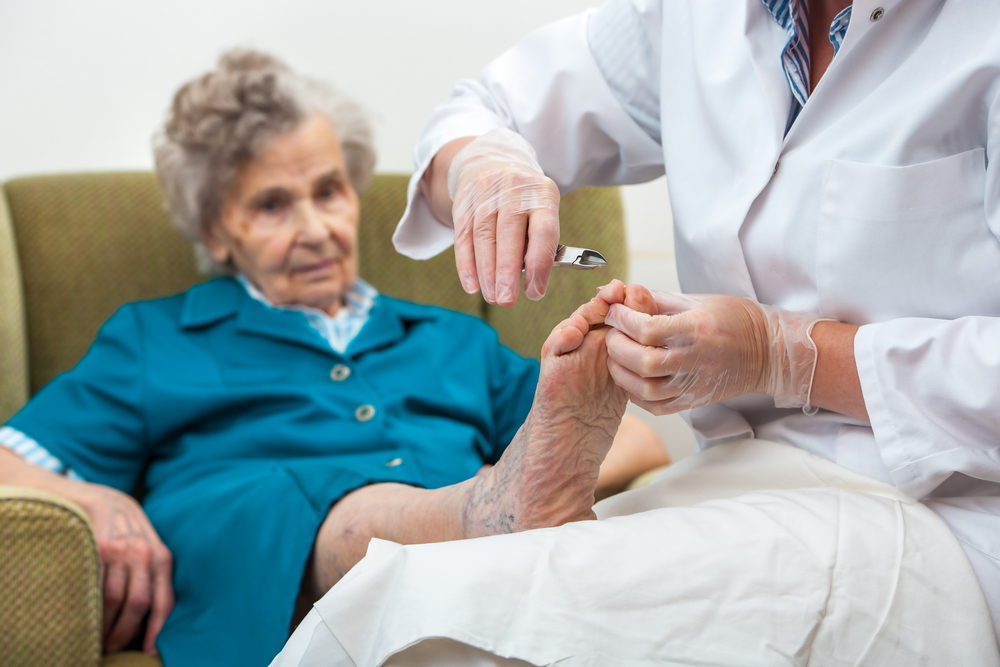 Many elderly people know the importance of maintaining proper foot care. The feet need to be healthy so immobility does not become a concern. When the toenails are trimmed correctly, ingrown toenails can be prevented. As the aging process occurs, it can become difficult to wash, dry, and trim the toenails. It may be easier if a caregiver can help to accomplish these tasks, in addition to noticing any sores or changes in skin color. It is beneficial to use a moisturizing lotion on the feet daily, as this is often helpful in preventing cracked heels. The feet will feel better when the correct size shoes are worn, and painful foot conditions that include bunions and hammertoes are prevented. If you would like additional information about care for elderly feet, it is suggested that you consult with a podiatrist.
Many elderly people know the importance of maintaining proper foot care. The feet need to be healthy so immobility does not become a concern. When the toenails are trimmed correctly, ingrown toenails can be prevented. As the aging process occurs, it can become difficult to wash, dry, and trim the toenails. It may be easier if a caregiver can help to accomplish these tasks, in addition to noticing any sores or changes in skin color. It is beneficial to use a moisturizing lotion on the feet daily, as this is often helpful in preventing cracked heels. The feet will feel better when the correct size shoes are worn, and painful foot conditions that include bunions and hammertoes are prevented. If you would like additional information about care for elderly feet, it is suggested that you consult with a podiatrist.
Proper foot care is something many older adults forget to consider. If you have any concerns about your feet and ankles, contact Dr. Scott Shrem from Garden State Foot & Ankle Center. Our doctor can provide the care you need to keep you pain-free and on your feet.
The Elderly and Their Feet
As we age we start to notice many changes in our body, but the elder population may not notice them right away. Medical conditions may prevent the elderly to take notice of their foot health right away. Poor vision is a lead contributor to not taking action for the elderly.
Common Conditions
- Neuropathy – can reduce feeling in the feet and can hide many life-threatening medical conditions.
- Reduced flexibility – prevents the ability of proper toenail trimming, and foot cleaning. If left untreated, it may lead to further medical issues.
- Foot sores – amongst the older population can be serious before they are discovered. Some of the problematic conditions they may face are:
- Gouging toenails affecting nearby toe
- Shoes that don’t fit properly
- Pressure sores
- Loss of circulation in legs & feet
- Edema & swelling of feet and ankles
Susceptible Infections
Diabetes and poor circulation can cause general loss of sensitivity over the years, turning a simple cut into a serious issue.
If you have any questions please feel free to contact our office located in Hazlet, NJ . We offer the newest diagnostic and treatment technologies for all your foot and ankle needs.
How Do Cracked Heels Develop?
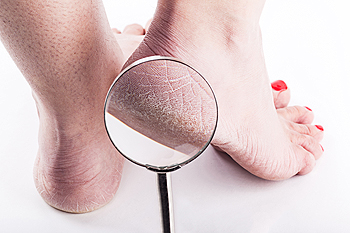 Many patients experience dry skin on the heels, and this is often the result of a lack of moisture in the skin on the feet. There are several reasons why this condition may develop. These consist of standing for extended periods of time throughout the day, wearing shoes that have an open back, or from being overweight. Additionally, there may be existing medical conditions that may contribute to the onset of cracked heels, which can include psoriasis, diabetes, or hypothyroidism. Mild relief may be found when the feet are washed and dried daily, followed by using a good moisturizer. If the cracks on the skin become severe, and appear to be deep, it is suggested to consult with a podiatrist who can recommend proper treatment options.
Many patients experience dry skin on the heels, and this is often the result of a lack of moisture in the skin on the feet. There are several reasons why this condition may develop. These consist of standing for extended periods of time throughout the day, wearing shoes that have an open back, or from being overweight. Additionally, there may be existing medical conditions that may contribute to the onset of cracked heels, which can include psoriasis, diabetes, or hypothyroidism. Mild relief may be found when the feet are washed and dried daily, followed by using a good moisturizer. If the cracks on the skin become severe, and appear to be deep, it is suggested to consult with a podiatrist who can recommend proper treatment options.
Cracked heels are unsightly and can cause further damage to your shoes and feet. If you have any concerns, contact Dr. Scott Shrem from Garden State Foot & Ankle Center. Our doctor can provide the care you need to keep you pain-free and on your feet.
Cracked Heels
Cracked heels appear unappealing and can make it harder for you walk around in sandals. Aside from looking unpleasant, cracked heels can also tear stockings, socks, and wear out your shoes. There are several methods to help restore a cracked heel and prevent further damage.
How Do You Get Them?
Dry skin is the number one culprit in creating cracked heels. Many athletes, walkers, joggers, and even swimmers suffer from cracked heels. Age and skin oil production play a role to getting cracked heels as well.
Promote Healing
Over the counter medicines can help, especially for those that need instant relief or who suffer from chronic dry feet.
Wear Socks – Wearing socks with medicated creams helps lock in moisture.
Moisturizers – Applying both day and night will help alleviate dryness which causes cracking.
Pumice Stones – These exfoliate and remove dead skin, which allows for smoother moisturizer application and better absorption into the skin.
Change in Diet
Eating healthy with a well-balanced diet will give the skin a fresh and radiant look. Your body responds to the kinds of food you ingest. Omega-3 fatty acids and zinc supplements can also revitalize skin tissue.
Most importantly, seek professional help if unsure how to proceed in treating cracked heels. A podiatrist will help you with any questions or information needed.
If you have any questions, please feel free to contact our office located in Hazlet, NJ . We offer the newest diagnostic and treatment technologies for all your foot care needs.
Solutions for Cracked Heels
Cracked heels can make life very frustrating and embarrassing when displaying the bare feet. Aside from being unpleasing to the eye, they can also tear stockings and socks and wear out shoes at a faster rate. When severe, cracked heels may cause pain or infection.
Cracked heels are a problem for those who are athletic, those who may walk a lot, and those who have especially dry skin. Those who use medication that dry the skin, those who swim often, wearing certain types of shoes, and those who are diabetic may have trouble with cracked heels. Seniors whose skin produces less oil may also have trouble with cracked feet. There is no one way to develop cracked feet, and there is no cure.
Today, the market consists of numerous products that have a variety of ingredients to promote healing. Some of these are over-the-counter. Others are prescribed by a doctor, especially for those who have chronic dry feet and heels.
Some doctors recommend wearing socks at night for those with rough skin. This helps further healing, and helps creams stay on longer and better absorb into the skin.
One way to alleviate dryness that causes cracked heels is by using moisturizers both day and night. Another way is to make sure the skin is clean and dry at all times. Using a pumice stone to buff away dead skin before putting on moisturizer can also help. Cracked heels will not respond to the cream unless the outer layer of skin is first removed through exfoliation. After exfoliation, lotion or ointment will be absorbed by the skin more easily.
Foods that produce healing and balance can also help the skin from within. Everything that is put into the body can either help it or hurt it. Taking supplements of omega-3 fatty acids and zinc can also be very beneficial.
Nevertheless, not all products are guaranteed to help treat cracked feet. Seeing a professional is best if other treatments options were unsuccessful. A podiatrist should be able to give the best advice to help with this problem.
It's Time for Beautiful Feet
Preventive Measures That Reduce the Risk of Falling
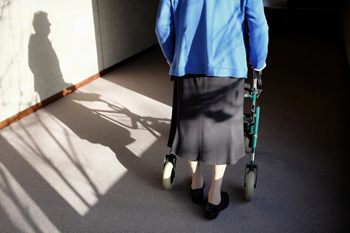 Research has indicated that falls are a common cause of injury in people who are sixty-five years of age and older. There are existing factors that may increase the risk of falling. These often include falls that have occurred in the past, wearing shoes that do not fit correctly, or poor vision. It is beneficial to practice a gentle exercise program frequently, as this may help to strengthen the body. There are methods that can be implemented which can help to prevent falls from occurring. These safety measures include installing grab bars in the bathroom and shower area, increasing the lighting in the home, and replacing worn carpets throughout the house. It is beneficial to measure the feet annually, which is important in determining the correct shoe size. This can help to avoid tripping. If you have questions on possible injuries the feet can endure as a result of falling, please consult with a podiatrist.
Research has indicated that falls are a common cause of injury in people who are sixty-five years of age and older. There are existing factors that may increase the risk of falling. These often include falls that have occurred in the past, wearing shoes that do not fit correctly, or poor vision. It is beneficial to practice a gentle exercise program frequently, as this may help to strengthen the body. There are methods that can be implemented which can help to prevent falls from occurring. These safety measures include installing grab bars in the bathroom and shower area, increasing the lighting in the home, and replacing worn carpets throughout the house. It is beneficial to measure the feet annually, which is important in determining the correct shoe size. This can help to avoid tripping. If you have questions on possible injuries the feet can endure as a result of falling, please consult with a podiatrist.
Preventing falls among the elderly is very important. If you are older and have fallen or fear that you are prone to falling, consult with Dr. Scott Shrem from Garden State Foot & Ankle Center. Our doctor will assess your condition and provide you with quality advice and care.
Every 11 seconds, an elderly American is being treated in an emergency room for a fall related injury. Falls are the leading cause of head and hip injuries for those 65 and older. Due to decreases in strength, balance, senses, and lack of awareness, elderly persons are very susceptible to falling. Thankfully, there are a number of things older persons can do to prevent falls.
How to Prevent Falls
Some effective methods that older persons can do to prevent falls include:
- Enrolling in strength and balance exercise program to increase balance and strength
- Periodically having your sight and hearing checked
- Discuss any medications you have with a doctor to see if it increases the risk of falling
- Clearing the house of falling hazards and installing devices like grab bars and railings
- Utilizing a walker or cane
- Wearing shoes that provide good support and cushioning
- Talking to family members about falling and increasing awareness
Falling can be a traumatic and embarrassing experience for elderly persons; this can make them less willing to leave the house, and less willing to talk to someone about their fears of falling. Doing such things, however, will increase the likelihood of tripping or losing one’s balance. Knowing the causes of falling and how to prevent them is the best way to mitigate the risk of serious injury.
If you have any questions, please feel free to contact our office located in Hazlet, NJ . We offer the newest diagnostic and treatment technologies for all your foot care needs.
Blog Archives
- April 2025
- March 2025
- February 2025
- January 2025
- December 2024
- November 2024
- October 2024
- September 2024
- August 2024
- July 2024
- June 2024
- May 2024
- April 2024
- March 2024
- February 2024
- January 2024
- December 2023
- November 2023
- October 2023
- September 2023
- August 2023
- July 2023
- June 2023
- May 2023
- April 2023
- March 2023
- February 2023
- January 2023
- December 2022
- November 2022
- October 2022
- September 2022
- August 2022
- July 2022
- June 2022
- May 2022
- April 2022
- March 2022
- February 2022
- January 2022
- December 2021
- November 2021
- October 2021
- September 2021
- August 2021
- July 2021
- June 2021
- May 2021
- April 2021
- March 2021
- February 2021
- January 2021
- December 2020
- November 2020
- October 2020
- September 2020
- August 2020
- July 2020
- June 2020
- May 2020
- April 2020
- March 2020
- February 2020
- January 2020
- December 2019
- November 2019
- October 2019
- September 2019
- August 2019
- July 2019
- June 2019
- May 2019
- April 2019
- March 2019
- February 2019
- January 2019
- December 2018
- November 2018
- October 2018
- September 2018
- August 2018
- July 2018
- June 2018
- May 2018
- April 2018
- March 2018









